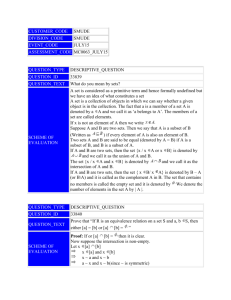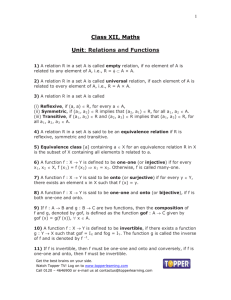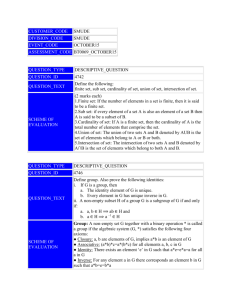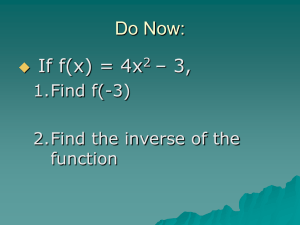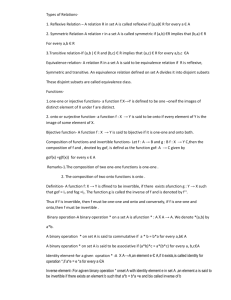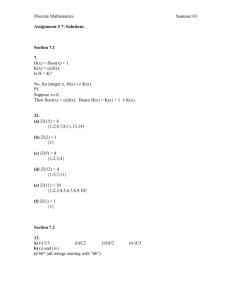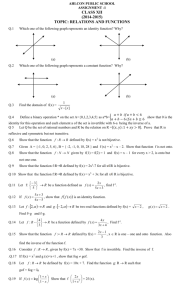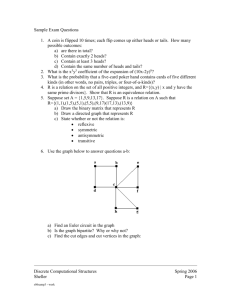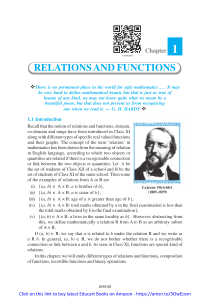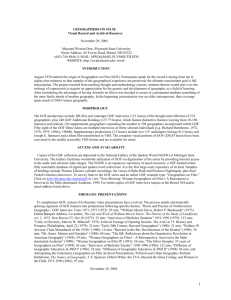CUSTOMER_CODE SMUDE DIVISION_CODE SMUDE
advertisement
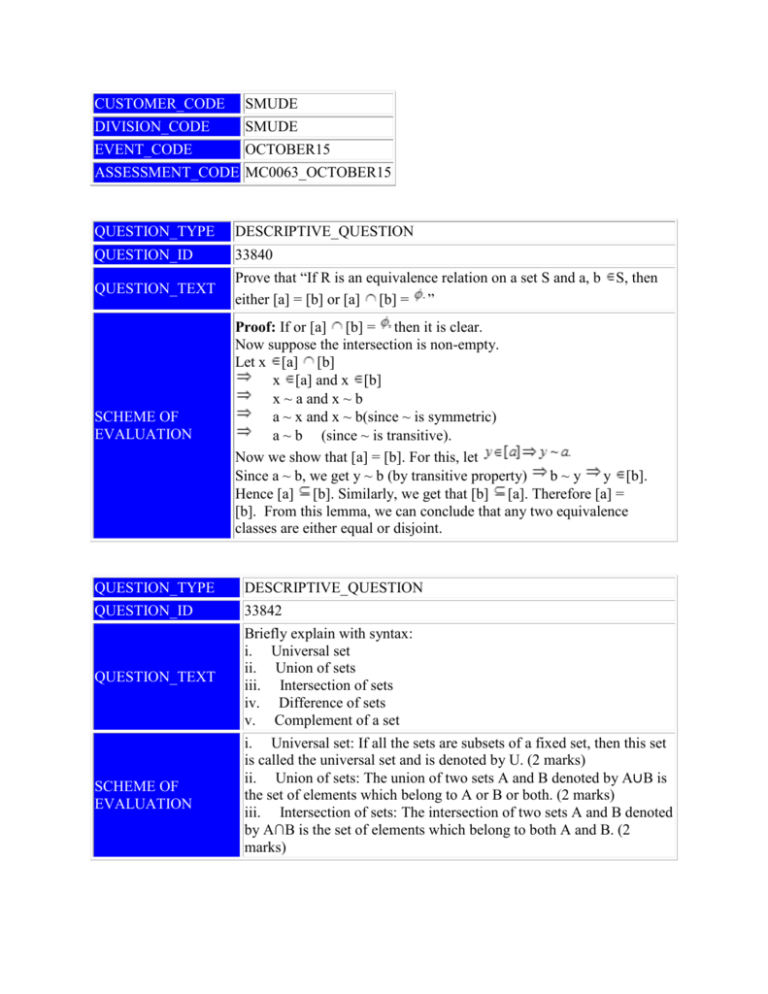
CUSTOMER_CODE
SMUDE
DIVISION_CODE
SMUDE
EVENT_CODE
OCTOBER15
ASSESSMENT_CODE MC0063_OCTOBER15
QUESTION_TYPE
DESCRIPTIVE_QUESTION
QUESTION_ID
33840
QUESTION_TEXT
Prove that “If R is an equivalence relation on a set S and a, b
either [a] = [b] or [a] [b] = ”
SCHEME OF
EVALUATION
Proof: If or [a] [b] = then it is clear.
Now suppose the intersection is non-empty.
Let x [a] [b]
x [a] and x [b]
x ~ a and x ~ b
a ~ x and x ~ b(since ~ is symmetric)
a ~ b (since ~ is transitive).
Now we show that [a] = [b]. For this, let
Since a ~ b, we get y ~ b (by transitive property)
b ~ y y [b].
Hence [a] [b]. Similarly, we get that [b] [a]. Therefore [a] =
[b]. From this lemma, we can conclude that any two equivalence
classes are either equal or disjoint.
S, then
QUESTION_TYPE
DESCRIPTIVE_QUESTION
QUESTION_ID
33842
QUESTION_TEXT
Briefly explain with syntax:
i. Universal set
ii. Union of sets
iii. Intersection of sets
iv. Difference of sets
v. Complement of a set
SCHEME OF
EVALUATION
i. Universal set: If all the sets are subsets of a fixed set, then this set
is called the universal set and is denoted by U. (2 marks)
ii. Union of sets: The union of two sets A and B denoted by A∪B is
the set of elements which belong to A or B or both. (2 marks)
iii. Intersection of sets: The intersection of two sets A and B denoted
by A∩B is the set of elements which belong to both A and B. (2
marks)
iv. Difference of sets: The difference of two sets A and B denoted
by A–B is the set of elements of A which are not the elements of B. (2
marks)
v. Complement of a set: The complement of a set A with respect to
the universal set U is defined as U–A and is denoted by AI or AC (2
marks)
QUESTION_TYPE
DESCRIPTIVE_QUESTION
QUESTION_ID
73749
QUESTION_TEXT
Prove that a function f has an inverse ⇔ f is one-one and onto.
SCHEME OF
EVALUATION
Suppose the inverse of f : S To T is g : T To S
By definition, gof(s) = s for all s in S and fog(t) = t for all t in T.
To show f is one-one, suppose a, b Belongs to S such that f(a) = f(b).
By applying the function g on both sides, we get gof(a) = gof(b).
Since gof is identity, we get a = gof(a) = gof(b) = b.
Hence f is one-one. To show f is onto, let t be an element of T. Write
x = g(t). The x is in S and f(x) = f(g(t)) = fog(t) = t. Hence f is onto.
Converse: Suppose f is one-one and onto.
Define g : T To S as g(t) = s where f(s) = t. To verify that g is a function,
suppose g(t) = a and g(t) = b. Then f(a) = t, f(b) = t.
So f(a) = f(b) which implies a = b (since f is one-one). Therefore g is a
function.
For all s in S, we have that gof(s) = g(f(s)) = g(t) = s (where t = f(s)).
Also for all t Belongs to T, we have fog(t) = f(g(t)) = f(s) = t. Hence g is
an inverse of f.
QUESTION_TYPE
DESCRIPTIVE_QUESTION
QUESTION_ID
105711
QUESTION_TEXT
Prove that a tree G with ‘n’ vertices has (n–1) edges.
Step (i): If n = 1, then G contains only one vertex and no edge.
So the number of edges in G is n – 1 = 1 – 1 = 0.
SCHEME OF
EVALUATION
Step (ii): Induction hypothesis: The statement is true for all trees
with less than ‘n’ vertices.
Step (iii): Let us consider a tree with ‘n’ vertices.
Let ‘ek’ be any edge in T whose and vertices are vi and vj
Since T is a tree, by theorem 9.2.6, there is no other path between vi
and vj.
So by removing ek from the T, we get a disconnected graph.
Also. T–ek consists of exactly two components (say T1 and T2).
Since T is a tree, there were no circuits in T and so there were no
circuits in T1 and T2. Therefore T1 and T2 are also trees.
It is clear that |V(T1)| + |V(T2)| = |V(T)| where V(T) denotes the set of
vertices in T.
Also |V(T1)| and |V(T2)| are less than n.
Therefore by the induction hypothesis, we have
|E(T1)| = |V(T1)| –1 and |E(T2)| = |V(T2)| –1.
Now |E(T)| – 1 = |E(T1)| + |E(T2)| = |V(T1)| –1 + |V(T2)|–1
Thus |E(T)| = |V(T1)| + |V(T2)| – 1 = |V(T)| – 1 = n–1.
QUESTION_TYPE
DESCRIPTIVE_QUESTION
QUESTION_ID
105713
Show that G = {–1, 1} is a commutative group.
QUESTION_TEXT
Prove the laws
Closure
Associative
SCHEME OF EVALUATION
Identity
Inverse
Commutative property
QUESTION_TYPE
DESCRIPTIVE_QUESTION
QUESTION_ID
105716
QUESTION_TEXT
Using the principle of mathematical induction show that 102n–1 + 1 is
divisible by 11 for all n N.
Let
Now
which is divisible by 11. Therefore
for some integer k. Consider
Therefore
SCHEME OF
EVALUATION
which is clearly divisible by 11.
Therefore
Therefore P(m+1) is divisible by 11.
Hence by the principle of mathematical induction P(n) is divisible by 11 for
all n.

